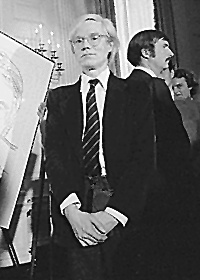I’ve been thinking a lot about Andy Warhol lately. He’s an artist I have a lot of respect for because he was so financially successful in his lifetime. And he got to have an awesome warehouse space filled with rad musicians and other artists.
When I win the lottery, the first thing I’m going to do is take a month-long European vacation. The next thing I’m going to do is rent a warehouse space and deck it out. I probably won’t paint it silver, but I promise, I will paint it. It will be the best few weeks ever. Then all day, every day, I will create–movies, paintings, sculpture–whatever strikes my fancy. I’ll invite other artists to share the space; rent out the film studio to artists for rock bottom prices. I’ll immediately take up neon sign making, an interest I’ve always had to forgo pursuing due to cost.
Andy Warhol didn’t rely on the lottery to live his dreams though he came from extremely modest means. He had business savvy from the get go; he made a name for himself as a commercial artist and earned the money he needed to live as a fine artist.
After making the switch, he maintained his business savvy. His silk screened canvases could be reproduced in record time and he quickly took on assistants to help him achieve a high level of production; how’s that for efficiency?
His first exhibit as a fine artist featured 100 cans of Campbell’s soup, 100 Coca Cola bottles and his dollar paintings. He had his eye on what everyone else had their eye on: celebrities, the objects of life. When he presented it in such a starkly different context, people were either charmed or bewildered. And yet, people were buying. Each creation of his fueled his Factory; his celebrity portraits soon became the standard mark of wealth.
Late in his life, he hired people who knew him well to write his Philosophy of Andy Warhol. History suggests that he was dyslexic and as such shied away from writing and speaking; instead using a tape recorder to capture his ideas. Those tape recordings formed the basis for his Philosophy.
An idea expressed in the book that struck me the other day: “Making money is art, and working is art and good business is the best art.”
I like to think Andy Warhol and I have a lot in common. As his homage to money to the left and his economic success testify, he was extremely motivated by money. As am I. Indeed, my first two stuffed animals pictured below were named Big Money and Little Money.
The similarities don’t end there. We both like sunglasses, warehouses and the Velvet Underground. And we are both driven by a need to create.
It’s this need to create that has always seemed at odds with economic gain. True, I’m making a living offering custom websites and graphic design. It’s wonderful and I am constantly thankful for clients old and new. Sometimes, though, the vision of the creation that’s haunting me has to play second fiddle to the creation that will pay the bills. I’m in the process of reworking my business model so that I can offer top of the line products at lower prices, while still maintaining my high standard of customer service and quality.
Andy Warhol sought to simplify his systems –and the product–whenever possible. When he created his portraits, he had a system– highlight the eyes, ears, mouth and hair. Ignore the rest. Everyone looks beautiful. Color regions differently and boom! I realized that to manage my business with efficient and effective ease I need simplicity and systems.
Good business is when the pieces work together like clock work. It’s a great business when it also gets to the heart of what your target market wants. And if they don’t know what they want, it makes it clear that your product is what they want, even if they didn’t know before they saw it. It’s a delicate balance of a myriad of elements, and as I strive to put the finishing touches on my new business plan, I thank Warhol’s colorful dollar signs everywhere for his shining example of how to make a living doing what you want to.




Leave a Reply